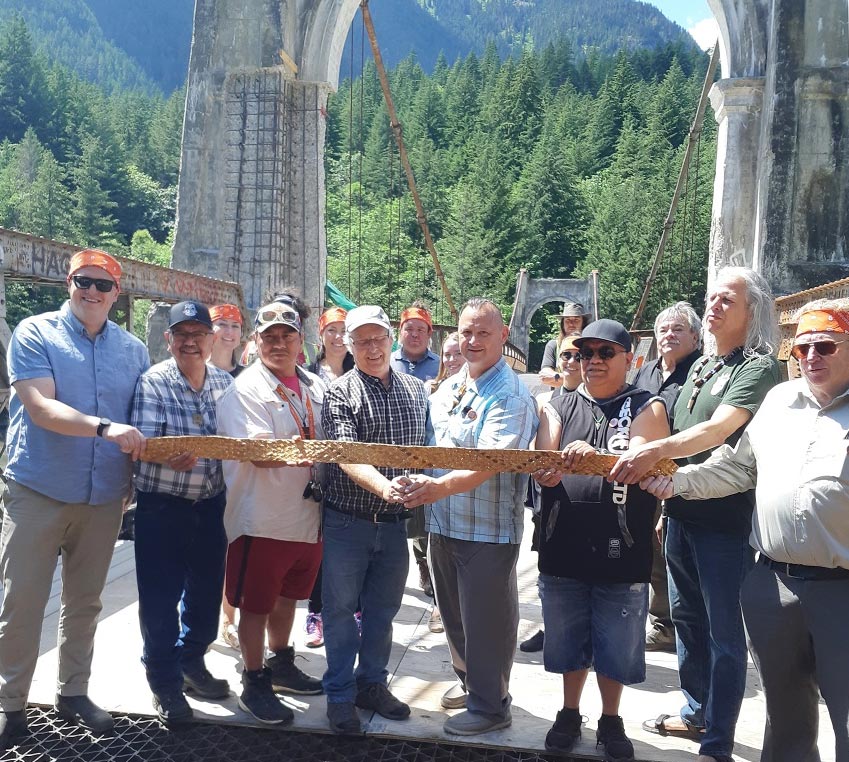(KEQUELOSE) The 1926 Alexandra Bridge Rehabilitation Project Partners celebrated the start of initial restoration work on the historic structure situated in the heart of the traditional territory of the Spuzzum First Nation. They were joined by elected officials, heritage tourism advocates and members of the Spuzzum First Nation (SFN) to mark the commencement of initial work to preserve an icon of British Columbia transportation history.
“We welcome all the guests, partners and supporters into our territory to celebrate the first steps being taken to restore the 1926 Alexandra Bridge,” says SFN Chief James Hobart.
“This beautiful structure was built at a natural crossing point that has been used by Indigenous Peoples for millennia to connect the Coast and the Interior. It’s the peak of an historic iceberg that goes back to time immemorial.”
A cedar ribbon cutting on the bridge highlighted the celebrations, which took place on July 13.
The SFN and the New Pathways to Gold Society (NPTGS) are the lead partners in a coalition that has worked since 2009 to preserve the bridge. Partners include Ministry of Transportation and Infrastructure (MOTI), BC Parks, BC Heritage Branch, Ministry of Forests, Lands and Natural Resource Development, CN and Heritageworks.
Participants got a chance to see work performed by Heritage Masonry based on engineering and other support that has helped to determine how best to repair the concrete in the support towers and other bridge elements such as railings.
“This is just the first step of what will likely be a three to five-year project,” says NPTGS Secretary Byron Spinks.
“The longer-term goal is to restore the structure to a pedestrian bridge that will provide visitors with an unforgettable experience of the Fraser Canyon in the traditional territory of the SFN.”
The 1926 Alexandra Bridge was built on the foundations of the original Cariboo Waggon Road bridge (constructed in 1863) near the ancient village of Kequelose, a traditional crossing point on the Fraser River. It was decommissioned in 1964 after the construction of the new Alexandra Bridge, two km downstream.
The old bridge is now the centerpiece of Alexandra Bridge Provincial Park, created in 1984.
The restoration work is being funded by the Community Economic Resiliency Infrastructure Program, which provided $500,000, and the Ministry of Transportation and Infrastructure (MOTI), which is contributing an additional $400,000.
Chief Hobart, who is also a NPTGS Director, says the rehabilitation of the 1926 Alexandra Bridge is the key to unlocking the economic potential of the Lower Canyon for his people.
“We’re developing a campsite, a convention centre, new housing and other amenities that we hope will make the Spuzzum First Nation the Canyon’s largest employer and the restored 1926 Alexandra Bridge is going to be at the heart of all of it,” says Hobart.
The bridge restoration is also important to creating opportunities for Indigenous and non-Indigenous communities not just in the Fraser Canyon, but throughout the Hope-Barkerville “Gold Rush/Spirit Trails” corridor.
“We want the 1926 Alexandra Bridge at Kequelose to be what it always has been for millennia – a gateway between the Coast and the Interior that will attract visitors and encourage them to keep going and explore the rest of the Gold Rush/Spirit Trails,” says NPTGS Indigenous Co-Chair Cheryl Chapman.
“There are hundreds of incredible Indigenous, non-Indigenous and Multicultural experiences to be had in what is the most culturally and geographically diverse corridor in all of B.C.”
You can find project updates on the NPTGS website at newpathwaystogold.ca. The project partners gratefully acknowledge the support of the Province of British Columbia though the Ministry of Forests, Lands and Natural Resource Development and the Ministry of Transportation and Infrastructure.


